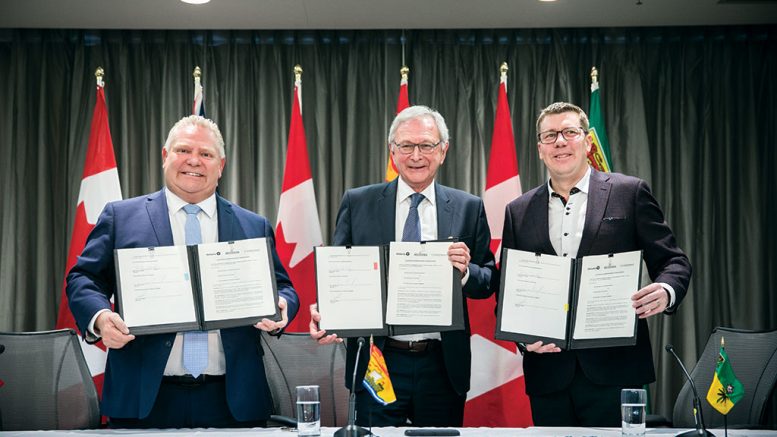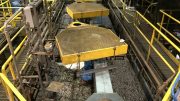The governments of Ontario, Saskatchewan and New Brunswick have signed a memorandum of understanding (MOU) committing their provinces to the development and deployment of a new type of nuclear technology known as small modular reactors (SMRs).
The decision by premiers Doug Ford, Scott Moe and Blaine Higgs is meant to help the provinces lower their carbon emissions while moving away from the use of nonrenewable energy sources such as coal.
The official communiqué signed on Dec. 1 states the three provinces will “work together to explore new, cutting-edge technology in nuclear power generation to provide carbon-free, affordable, reliable and safe energy, while helping us unlock economic potential across Canada, including rural and remote regions.”
As the second-largest producer of uranium in the world after Kazakhstan, Canadian miners are welcoming the MOU, especially as the sector has struggled over the last eight years with weak uranium prices. Spot uranium oxide now hovers around US$26 per pound.
SMRs are nuclear fission reactors that differ from traditional nuclear reactors in several ways. In the public mind, nuclear power is generated by large, expensive units such as the CANDU reactors operated by Ontario Power Generation and NB Power. (Hydro-Québec’s Gentilly Nuclear Generating Station has been decommissioned.) The 18 CANDU reactors operating in Ontario and New Brunswick are individually capable of generating between 515 and 881 megawatts of electricity (MWe). That means that at the top end of the output spectrum, a CANDU reactor can generate enough electricity to power 600,000 homes.
By comparison, SMRs are considered to be units that generate less than 300 MWe, with a subcategory of very small reactors each producing under 15 MWe. And unlike the immense physical size of CANDU plants, SMRs can be small enough to fit within a school gymnasium and transported in shipping containers. This offers considerably more flexibility in situating SMR power plants to remote locations or other sites where conventional nuclear stations could never be built. And besides off-grid use, SMRs could also be used to augment existing on-grid power generation, especially in places phasing out coal in the near future.

Bruce Power is Ontario’s largest independent generator of electricity. Credit: Candu Owners Group.
The modular aspect of SMRs refers to the ability for the units to be pre-built in a factory, made easily portable, and also scalable to site-specific requirements. This could allow a small reactor to operate on its own or as a component part of a larger facility, creating flexibility for a power station to adapt to changes in energy consumption by expanding or reducing the number of generating modules as needed.
Ontario, Saskatchewan and New Brunswick have been involved in the creation of what is known as the Canadian SMR Roadmap. The Roadmap was released by Natural Resources Canada in November 2018, created in partnership with other provincial and territorial governments and a number of power utilities. Its stated goal is the intention of engaging various stakeholders within Canada’s nuclear energy community on the future of SMRs, which would include the country’s uranium miners.
According to the Roadmap, Canada has one of the most promising domestic markets for SMRs, with conservative estimates placing the potential value for SMRs in Canada at $5.3 billion between 2025 and 2040. The global market is even more promising, with an estimated conservative valuation of $150 billion in the same time frame, creating the potential for a large export market for the Canadian nuclear industry.
However one of the biggest challenges for the nuclear industry is the simple fact that operational SMRs are still some way off from actually producing electricity. While there are over 150 proposed designs worldwide, according to the Roadmap, it could be seven to 15 years before most are available to be deployed.
But for Canadian uranium miners, just the fact that the MOU was signed is an important move in supporting their sector.
“It’s a very positive, proactive step that we’re taking in Canada to be out in front of this technology, and take advantage of the skill set we have [here] to advance this,” Jim Corman, president and CEO of Orano Canada, tells The Northern Miner. “SMRs have been discussed for decades. But there hasn’t been, in North America, an outward expression of commitment to the technology like what has been made here with this MOU. It gets the discussion started as well in the public domain. It starts bringing nuclear back to the forefront in terms of the benefits that nuclear power can bring.”

Ross McElroy (left) with a colleague (unknown) at Fission Uranium’s Patterson Lake South project in Saskatchewan. Credit: Fission Uranium.
Ross McElroy, president and chief operating officer of Fission Uranium (TSX: FCU), calls the MOU a win-win for all involved. “It gives the nuclear industry another option, and a big option,” he says in an interview. “The benefits of why people like nuclear in the first place, or should like it, is the fact that you have baseload power 24 hours a day, seven days a week. There’s nothing else other than fossil fuels that does that.”
McElroy also highlights two other aspects of SMRs: safety and carbon emissions. “Everybody that knows anything about it recognizes that it’s a very safe form of energy,” he says. “It doesn’t have any negative CO2 gas, your carbon footprint is essentially zero. So seeing the governments support this, it’s an important new evolution in the nuclear sector. It will have a positive impact on mining in general.”
Still, they are under no illusion that this will improve the uranium market any time soon.
“For the uranium mining sector in the short-term, this probably doesn’t make a significant difference to immediate demand,” Corman says. “The spot price certainly hasn’t jumped anything on this announcement and continues to languish at historically low levels. [But] any time you can get an east–west kind of collaboration MOU going, we think that’s a positive thing. It’s showing the commitment from multiple government levels that nuclear needs to fit into our energy solutions. It’s been a while since that discussion has been prominent in the public domain.”
Fission Uranium’s McElroy adds that the potential demand for uranium to power SMRs could motivate more exploration. “You know it takes so long to go from a discovery of a deposit to production, a 10- to 15-year cycle. So if you’re looking for new sources of uranium for 10 or 15 years out, you need to be exploring right now.”
McElroy hopes the MOU will expand interest in SMRs. “I would like to see more provinces involved with this thing. I think it’s key to have Saskatchewan, Ontario and New Brunswick in there right now, but I’d love to see Alberta, for instance, come on board with this. When you think of the energy needed for the oilsands, there’s a huge potential for [SMRs] to provide power for the operations there.”
— Daniel Sekulich is a Toronto-based author and writer.





Great to see progression on the way of the future to reduce greenhouse gas and improve the environment especially for smaller isolated areas that rely on diesel or coal power systems.